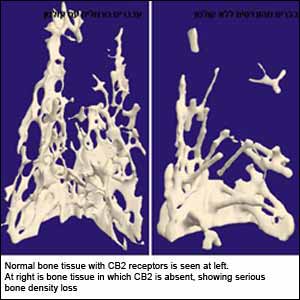Scientists Develop Prototype Drug to Prevent Osteoporosis Based on Cannabinoids Produced by Body

Substances produced in the body that act like those found in the cannabis plant help preserve bone density, according to researchers at the Hebrew University of Jerusalem. Based on this finding, a prototype for a new drug to prevent osteoporosis (loss of bone density) without any psychoactive side effects has already been developed.
An article describing this research appears this week in the prestigious American journal PNAS (Proceedings of the National Academy of Sciences of the U.S.A.). The researchers, from the Bone Laboratory of the Hebrew University, are headed by Prof. Itai Bab, working in cooperation with Prof. Esther Shohami of the Laboratory for the Study of Bain Trauma; Prof. Raphael Mechoulam of the Hebrew University School of Pharmacy; doctoral students Orr Ofek, Vardits Krem and Yossi Tam; and master’s degree student Meirav Fogel.
Substances made in the body called endocannabinoids are composed mainly of fatty acids which were discovered during the last 15 years. (The fatty acid anandamid was discovered by Prof. Mechoulam in 1992.) These materials, which are produced mainly in the brain, are present also in the bone and other tissues and have similar effects to those of the active components in hashish and marijuana, produced from the cannabis plant.
These substances bind to and activate two receptors, CB1 and CB2. The first is found in the nervous system and is responsible for the psychoactive effects of the active components in the cannabis plant and endocannanoids. The second receptor is found in the immune system. It is not known to be involved with psychoactive responses, and there has been little information about its physiological function.
The Hebrew University researchers discovered a high level of CB2 receptors in bone, and that this is required in order to preserve normal bone density. Together with their colleagues at the University of Bonn, Germany, Prof. Andreas Zimmer and Dr. Malia Karasek, they studied the skeletons of genetically engineered mice lacking the CB2 receptor. As they aged, these CB2-deprived mice developed severe osteoporosis, similar to that which appears in humans. Osteoporosis is the most widespread degenerative disease in developed countries and can lead to multiple fractures, disability and complications, and even death.
The scientists’ findings have thus assigned, for the first time, a physiological function to CB2 in preserving bone density and showed that it stimulates bone building and reduces bone loss. This indicates that substances that active the CB2 receptor can be used as basis for the development of drugs for osteoporosis patients. Indeed, the Hebrew University researchers have developed a new synthetic compound, HU-308, which activates CB2 and slows the development of osteoporosis in mice. This compound forms the basis for a cannabinoid-based, anti-osteoporotic type drug which has also been found to be free of any psychoactive side effects.
The Hebrew University research was conducted within the framework of a project directed at clarifying the connection between the brain, behavior and changes in skeletal structure. The research was funded by the Bikura (First) Program of the Israel Science Foundation, which supports pioneering, innovative, interdisciplinary projects. The research also received funding from the U.S. National Institutes of Health.
Media Contact
More Information:
http://www.huji.ac.ilAll latest news from the category: Life Sciences and Chemistry
Articles and reports from the Life Sciences and chemistry area deal with applied and basic research into modern biology, chemistry and human medicine.
Valuable information can be found on a range of life sciences fields including bacteriology, biochemistry, bionics, bioinformatics, biophysics, biotechnology, genetics, geobotany, human biology, marine biology, microbiology, molecular biology, cellular biology, zoology, bioinorganic chemistry, microchemistry and environmental chemistry.
Newest articles

Innovative 3D printed scaffolds offer new hope for bone healing
Researchers at the Institute for Bioengineering of Catalonia have developed novel 3D printed PLA-CaP scaffolds that promote blood vessel formation, ensuring better healing and regeneration of bone tissue. Bone is…

The surprising role of gut infection in Alzheimer’s disease
ASU- and Banner Alzheimer’s Institute-led study implicates link between a common virus and the disease, which travels from the gut to the brain and may be a target for antiviral…

Molecular gardening: New enzymes discovered for protein modification pruning
How deubiquitinases USP53 and USP54 cleave long polyubiquitin chains and how the former is linked to liver disease in children. Deubiquitinases (DUBs) are enzymes used by cells to trim protein…



